Satellite Observations Reveal Northward Vegetation Greenness Shifts in the Greater Mekong Subregion over the Past 23 Years
Abstract
1. Introduction
2. Materials and Methods
2.1. Study Area
2.2. Data Resources and Preprocessing
2.3. Methods
2.3.1. Mann–Kendall Mutation Test
2.3.2. Trend Analysis
2.3.3. Gravity Center Migration Model
3. Results
3.1. Spatiotemporal Variation in Vegetation Cover
3.1.1. Spatial Distribution Patterns of Vegetation Coverage
3.1.2. Temporal Variations in Vegetation Coverage
3.2. Change Trends in Vegetation Coverage
3.3. Spatiotemporal Variation in Vegetation Cover across Different Countries
3.4. Characteristics of Shifting Vegetation Coverage Gravity Center
4. Discussion
4.1. Trend Changes in the Interannual NDVI Fluctuations
4.2. Differences in NDVI Change Trends in the GMS Countries
4.3. Limitations and Perspectives
5. Conclusions
Author Contributions
Funding
Data Availability Statement
Acknowledgments
Conflicts of Interest
References
- Chen, H.; Zhu, T. The complexity of cooperative governance and optimization of institutional arrangements in the Greater Mekong Subregion. Land Use Policy 2016, 50, 363–370. [Google Scholar] [CrossRef]
- Liu, Z.; Liu, W. Message from the workshop chairs HighCloud 2011. In Proceedings of the 2011 14th IEEE International Conference on Computational Science and Engineering, Dalian, China, 24–26 August 2011. [Google Scholar] [CrossRef]
- Chen, A.L.Q. The Belt and Road Initiative as a variegated agglomeration of multi-scalar state spatial strategies. Territ. Politics Gov. 2023, 11, 478–501. [Google Scholar] [CrossRef]
- Chen, B.Z.; Kayiranga, A.; Ge, M.Y.; Ciais, P.; Zhang, H.F.; Black, A.; Xiao, X.M.; Yuan, W.P.; Zeng, Z.Z.; Piao, S.L. Anthropogenic activities dominated tropical forest carbon balance in two contrary ways over the Greater Mekong Subregion in the 21st century. Glob. Chang. Biol. 2023, 29, 3421–3432. [Google Scholar] [CrossRef] [PubMed]
- Pungkul, S.; Suraswasdi, C.; Phonekeo, V. Implementation of forest cover and carbon mapping in the Greater Mekong subregion and Malaysia project—A case study of Thailand. In Proceedings of the 8th International Symposium of the Digital Earth (ISDE), Kuching, Malaysia, 26–29 August 2013. [Google Scholar]
- Liu, C.L.; Li, W.L.; Wang, W.Y.; Zhou, H.K.; Liang, T.G.; Hou, F.J.; Xu, J.; Xue, P.F. Quantitative spatial analysis of vegetation dynamics and potential driving factors in a typical alpine region on the northeastern Tibetan Plateau using the Google Earth Engine. Catena 2021, 206, 105500. [Google Scholar] [CrossRef]
- Piao, S.L.; Yin, G.D.; Tan, J.G.; Cheng, L.; Huang, M.T.; Li, Y.; Liu, R.G.; Mao, J.F.; Myneni, R.B.; Peng, S.S.; et al. Detection and attribution of vegetation greening trend in China over the last 30 years. Glob. Chang. Biol. 2015, 21, 1601–1609. [Google Scholar] [CrossRef]
- Liu, C.X.; Zhang, X.D.; Wang, T.; Chen, G.Z.; Zhu, K.; Wang, Q.; Wang, J. Detection of vegetation coverage changes in the Yellow River Basin from 2003 to 2020. Ecol. Indic. 2022, 138, 108818. [Google Scholar] [CrossRef]
- Zhai, J.H.; Xiao, C.W.; Feng, Z.M.; Liu, Y. Are there suitable global datasets for monitoring of land use and land cover in the tropics? Evidences from mainland Southeast Asia. Glob. Planet. Chang. 2023, 229, 104233. [Google Scholar] [CrossRef]
- Davis, K.F.; Yu, K.L.; Rulli, M.C.; Pichdara, L.; D’Odorico, P. Accelerated deforestation driven by large-scale land acquisitions in Cambodia. Nat. Geosci. 2015, 8, 772–775. [Google Scholar] [CrossRef]
- Zeng, Z.Z.; Estes, L.; Ziegler, A.D.; Chen, A.P.; Searchinger, T.; Hua, F.Y.; Guan, K.Y.; Jintrawet, A.; Wood, E.F. Highland cropland expansion and forest loss in Southeast Asia in the twenty-first century. Nat. Geosci. 2018, 11, 556–562. [Google Scholar] [CrossRef]
- Fan, F.F.; Xiao, C.W.; Feng, Z.M.; Yang, Y.Z. Impact of human and climate factors on vegetation changes in mainland southeast asia and yunnan province of China. J. Clean. Prod. 2023, 415, 137690. [Google Scholar] [CrossRef]
- Zhong, X.Z.; Li, J.; Wang, J.L.; Zhang, J.P.; Liu, L.F.; Ma, J. Linear and Nonlinear Characteristics of Long-Term NDVI Using Trend Analysis: A Case Study of Lancang-Mekong River Basin. Remote Sens. 2022, 14, 6271. [Google Scholar] [CrossRef]
- Yang, S.F.; Zhao, Y.L.; Yang, D.; Lan, A.J. Analysis of Vegetation NDVI Changes and Driving Factors in the Karst Concentration Distribution Area of Asia. Forests 2024, 15, 398. [Google Scholar] [CrossRef]
- Li, S.; Yang, S.; Liu, X.; Liu, Y.; Shi, M. NDVI-Based Analysis on the Influence of Climate Change and Human Activities on Vegetation Restoration in the Shaanxi-Gansu-Ningxia Region, Central China. Remote Sens. 2015, 7, 11163–11182. [Google Scholar] [CrossRef]
- Hashimoto, H.; Wang, W.L.; Dungan, J.L.; Li, S.; Michaelis, A.R.; Takenaka, H.; Higuchi, A.; Myneni, R.B.; Nemani, R.R. New generation geostationary satellite observations support seasonality in greenness of the Amazon evergreen forests. Nat. Commun. 2021, 12, 684. [Google Scholar] [CrossRef] [PubMed]
- Li, J.; Wang, J.; Zhang, J.; Zhang, J.; Kong, H. Dynamic changes of vegetation coverage in China-Myanmar economic corridor over the past 20 years. Int. J. Appl. Earth Obs. Geoinf. 2021, 102, 102378. [Google Scholar] [CrossRef]
- Beck, H.E.; McVicar, T.R.; van Dijk, A.; Schellekens, J.; de Jeu, R.A.M.; Bruijnzeel, L.A. Global evaluation of four AVHRR-NDVI data sets: Intercomparison and assessment against Landsat imagery. Remote Sens. Environ. 2011, 115, 2547–2563. [Google Scholar] [CrossRef]
- Bai, Y.Q.; Yang, Y.P.; Jiang, H. Intercomparison of AVHRR GIMMS3g, Terra MODIS, and SPOT-VGT NDVI Products over the Mongolian Plateau. Remote Sens. 2019, 11, 2030. [Google Scholar] [CrossRef]
- Kang, Y.; Guo, E.L.; Wang, Y.F.; Bao, Y.L.; Bao, Y.H.; Mandula, N. Monitoring Vegetation Change and Its Potential Drivers in Inner Mongolia from 2000 to 2019. Remote Sens. 2021, 13, 3357. [Google Scholar] [CrossRef]
- Zhe, M.; Zhang, X.Q. Time-lag effects of NDVI responses to climate change in the Yamzhog Yumco Basin, South Tibet. Ecol. Indic. 2021, 124, 107431. [Google Scholar] [CrossRef]
- Cheng, J.; Qian, M.J.; Liu, J.F.; Chen, X.F.; Zuo, Y.T.; Zhao, Z.Q.; Zhang, J.J. How Did the Southwest China Mountains Turn Green from 2000 to 2020? A Case Study in Chongqing. Forests 2023, 14, 1563. [Google Scholar] [CrossRef]
- Liu, G.L.; Li, J.Y.; Nie, P. Tracking the history of urban expansion in Guangzhou (China) during 1665-2017: Evidence from historical maps and remote sensing images. Land Use Policy 2022, 112, 105773. [Google Scholar] [CrossRef]
- Dai, Y.J.; Tian, L.; Zhu, P.Z.; Dong, Z.; Zhang, R.H. Dynamic aeolian erosion evaluation and ecological service assessment in Inner Mongolia, northern China. Geoderma 2022, 406, 115518. [Google Scholar] [CrossRef]
- Han, Z.; Song, W. Interannual trends of vegetation and responses to climate change and human activities in the Great Mekong Subregion. Glob. Ecol. Conserv. 2022, 38, e02215. [Google Scholar] [CrossRef]
- A, D.; Zhao, W.; Qu, X.; Jing, R.; Xiong, K. Spatio-temporal variation of vegetation coverage and its response to climate change in North China plain in the last 33 years. Int. J. Appl. Earth Obs. Geoinf. 2016, 53, 103–117. [Google Scholar] [CrossRef]
- Bai, Y.; Li, S.; Liu, M.; Guo, Q. Assessment of vegetation change on the Mongolian Plateau over three decades using different remote sensing products. J. Environ. Manag. 2022, 317, 115509. [Google Scholar] [CrossRef] [PubMed]
- Zhang, X.; Wang, G.; Xue, B.; Yinglan, A. Changes in vegetation cover and its influencing factors in the inner Mongolia reach of the yellow river basin from 2001 to 2018. Environ. Res. 2022, 215, 114253. [Google Scholar] [CrossRef]
- Liu, Z.; Wang, H.; Li, N.; Zhu, J.; Pan, Z.; Qin, F. Spatial and Temporal Characteristics and Driving Forces of Vegetation Changes in the Huaihe River Basin from 2003 to 2018. Sustainability 2020, 12, 2198. [Google Scholar] [CrossRef]
- Ren, Z.; Tian, Z.; Wei, H.; Liu, Y.; Yu, Y. Spatiotemporal evolution and driving mechanisms of vegetation in the Yellow River Basin, China during 2000–2020. Ecol. Indic. 2022, 138, 108832. [Google Scholar] [CrossRef]
- Liu, C.; Li, W.; Xu, J.; Zhou, H.; Wang, W.; Wang, H. Temporal and spatial variations of ecological security on the northeastern Tibetan Plateau integrating ecosystem health-risk-services framework. Ecol. Indic. 2024, 158, 111365. [Google Scholar] [CrossRef]
- Janes, T.; McGrath, F.; Macadam, I.; Jones, R. High-resolution climate projections for South Asia to inform climate impacts and adaptation studies in the Ganges-Brahmaputra-Meghna and Mahanadi deltas. Sci. Total Environ. 2019, 650, 1499–1520. [Google Scholar] [CrossRef]
- Chen, B.Z.; Xu, G.; Coops, N.C.; Ciais, P.; Innes, J.L.; Wang, G.Y.; Myneni, R.B.; Wang, T.L.; Krzyzanowski, J.; Li, Q.L.; et al. Changes in vegetation photosynthetic activity trends across the Asia-Pacific region over the last three decades. Remote Sens. Environ. 2014, 144, 28–41. [Google Scholar] [CrossRef]
- Piao, S.L.; Wang, X.H.; Park, T.; Chen, C.; Lian, X.; He, Y.; Bjerke, J.W.; Chen, A.P.; Ciais, P.; Tommervik, H.; et al. Characteristics, drivers and feedbacks of global greening. Nat. Rev. Earth Environ. 2020, 1, 14–27. [Google Scholar] [CrossRef]
- Chen, C.; Park, T.; Wang, X.H.; Piao, S.L.; Xu, B.D.; Chaturvedi, R.K.; Fuchs, R.; Brovkin, V.; Ciais, P.; Fensholt, R.; et al. China and India lead in greening of the world through land-use management. Nat. Sustain. 2019, 2, 122–129. [Google Scholar] [CrossRef] [PubMed]
- Baehr, C.; BenYishay, A.; Parks, B. Highway to the forest? Land governance and the siting and environmental impacts of Chinese government-funded road building in Cambodia. J. Environ. Econ. Manag. 2023, 122, 102898. [Google Scholar] [CrossRef]
- Cheong, W.K.; Timbal, B.; Golding, N.; Sirabaha, S.; Kwan, K.F.; Cinco, T.A.; Archevarahuprok, B.; Vo, V.H.; Gunawan, D.; Han, S. Observed and modelled temperature and precipitation extremes over Southeast Asia from 1972 to 2010. Int. J. Climatol. 2018, 38, 3013–3027. [Google Scholar] [CrossRef]
- Xiong, Y.L.; Wang, H.L. Spatial relationships between NDVI and topographic factors at multiple scales in a watershed of the Minjiang River, China. Ecol. Inform. 2022, 69, 101617. [Google Scholar] [CrossRef]
- Ma, Y.Q.; Huang, L.; Li, J.H.; Cao, W.; Cai, Y.M. Carbon potential of China’s Grain to Green Program and its contribution to the carbon target. Resour. Conserv. Recycl. 2024, 200, 107272. [Google Scholar] [CrossRef]
- Huang, W.; Wang, P.; He, L.; Liu, B. Improvement of water yield and net primary productivity ecosystem services in the Loess Plateau of China since the “Grain for Green” project. Ecol. Indic. 2023, 154, 110707. [Google Scholar] [CrossRef]
- Wu, X.; Sun, X.M.; Wang, Z.F.; Zhang, Y.L.; Liu, Q.H.; Zhang, B.H.; Paudel, B.; Xie, F.D. Vegetation Changes and Their Response to Global Change Based on NDVI in the Koshi River Basin of Central Himalayas Since 2000. Sustainability 2020, 12, 6644. [Google Scholar] [CrossRef]
- Tölle, M.H.; Engler, S.; Panitz, H.J. Impact of Abrupt Land Cover Changes by Tropical Deforestation on Southeast Asian Climate and Agriculture. J. Clim. 2017, 30, 2587–2600. [Google Scholar] [CrossRef]
- Wang, Q.; Moreno-Martinez, A.; Munoz-Mari, J.; Campos-Taberner, M.; Camps-Valls, G. Estimation of vegetation traits with kernel NDVI. Isprs J. Photogramm. Remote Sens. 2023, 195, 408–417. [Google Scholar] [CrossRef]
- Yang, S.J.; Song, S.; Li, F.D.; Yu, M.Z.; Yu, G.M.; Zhang, Q.Y.; Cui, H.T.; Wang, R.; Wu, Y.Q. Vegetation coverage changes driven by a combination of climate change and human activities in Ethiopia, 2003–2018. Ecol. Inform. 2022, 71, 101776. [Google Scholar] [CrossRef]
- Liu, Y.; Zhang, X.; Du, X.; Du, Z.; Sun, M. Alpine grassland greening on the Northern Tibetan Plateau driven by climate change and human activities considering extreme temperature and soil moisture. Sci. Total Environ. 2024, 916, 169995. [Google Scholar] [CrossRef] [PubMed]
- Zhao, X.Y.; Tan, S.C.; Li, Y.P.; Wu, H.; Wu, R.J. Quantitative analysis of fractional vegetation cover in southern Sichuan urban agglomeration using optimal parameter geographic detector model, China. Ecol. Indic. 2024, 158, 111529. [Google Scholar] [CrossRef]
- Wang, W.S.; Yang, Y.S. Spatial-temporal differentiation characteristics and driving factors of China’s energy eco-efficiency based on geographical detector model. J. Clean. Prod. 2024, 434, 140153. [Google Scholar] [CrossRef]
- Gu, Z.J.; Duan, X.W.; Shi, Y.D.; Li, Y.; Pan, X. Spatiotemporal variation in vegetation coverage and its response to climatic factors in the Red River Basin, China. Ecol. Indic. 2018, 93, 54–64. [Google Scholar] [CrossRef]
- Yan, X.X.; Li, J.; Shao, Y.; Hu, Z.Q.; Yang, Z.; Yin, S.Q.; Cui, I. Driving forces of grassland vegetation changes in Chen Barag Banner, Inner Mongolia. GISci. Remote Sens. 2020, 57, 753–769. [Google Scholar] [CrossRef]
- Guan, Y.L.; Lu, H.W.; Yin, C.; Xue, Y.X.; Jiang, Y.L.; Kang, Y.; He, L.; Heiskanen, J. Vegetation response to climate zone dynamics and its impacts on surface soil water content and albedo in China. Sci. Total Environ. 2020, 747, 141537. [Google Scholar] [CrossRef]
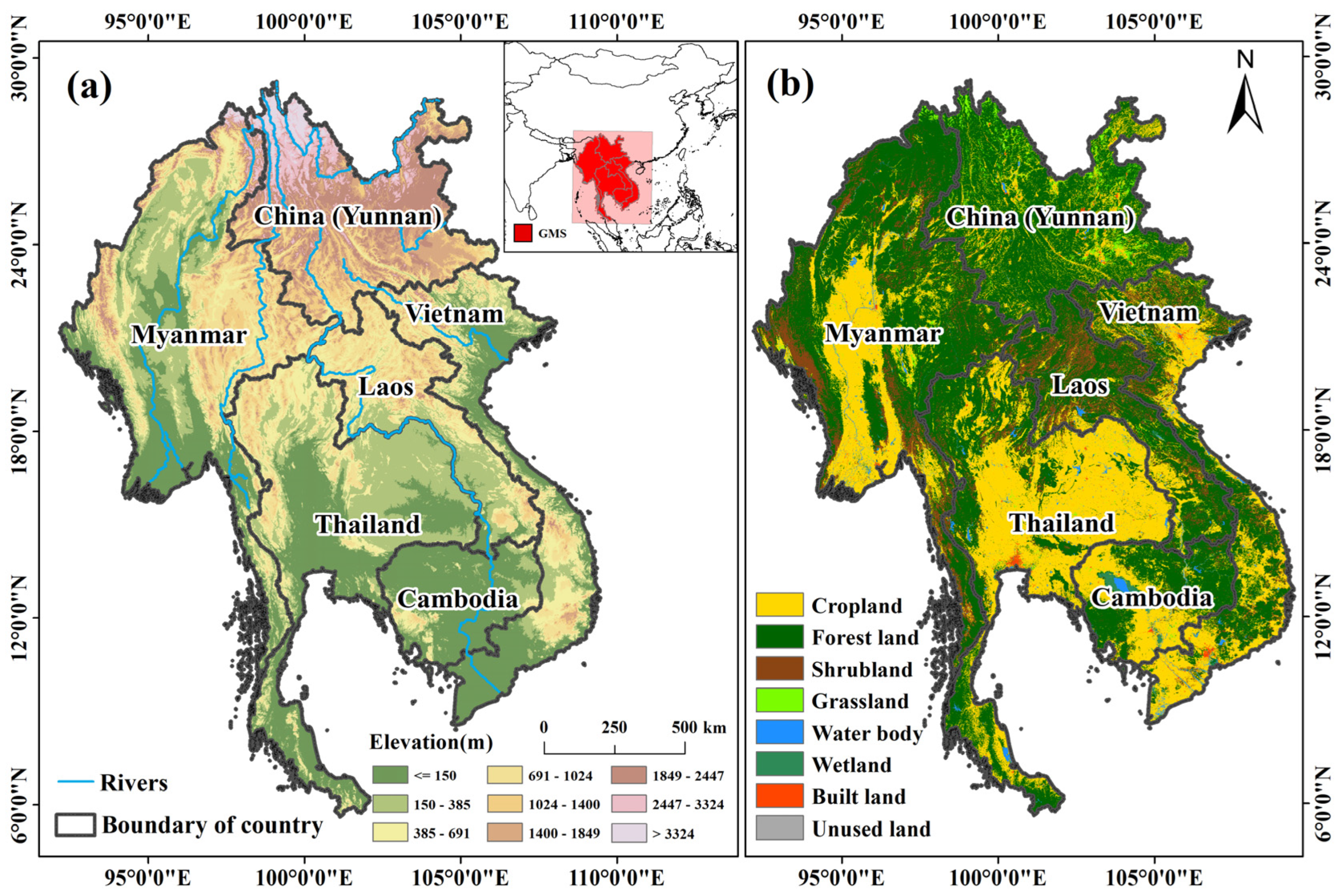
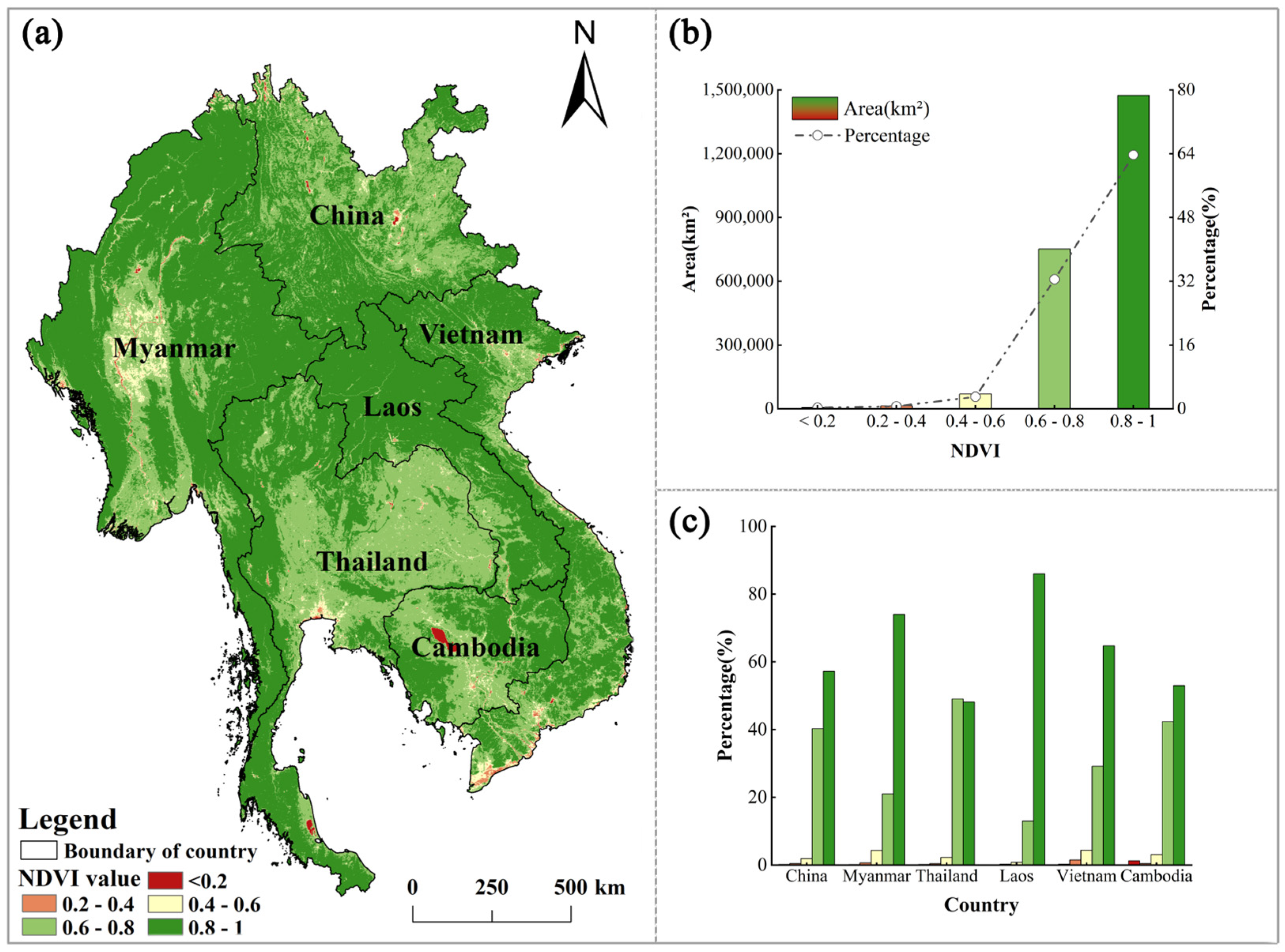

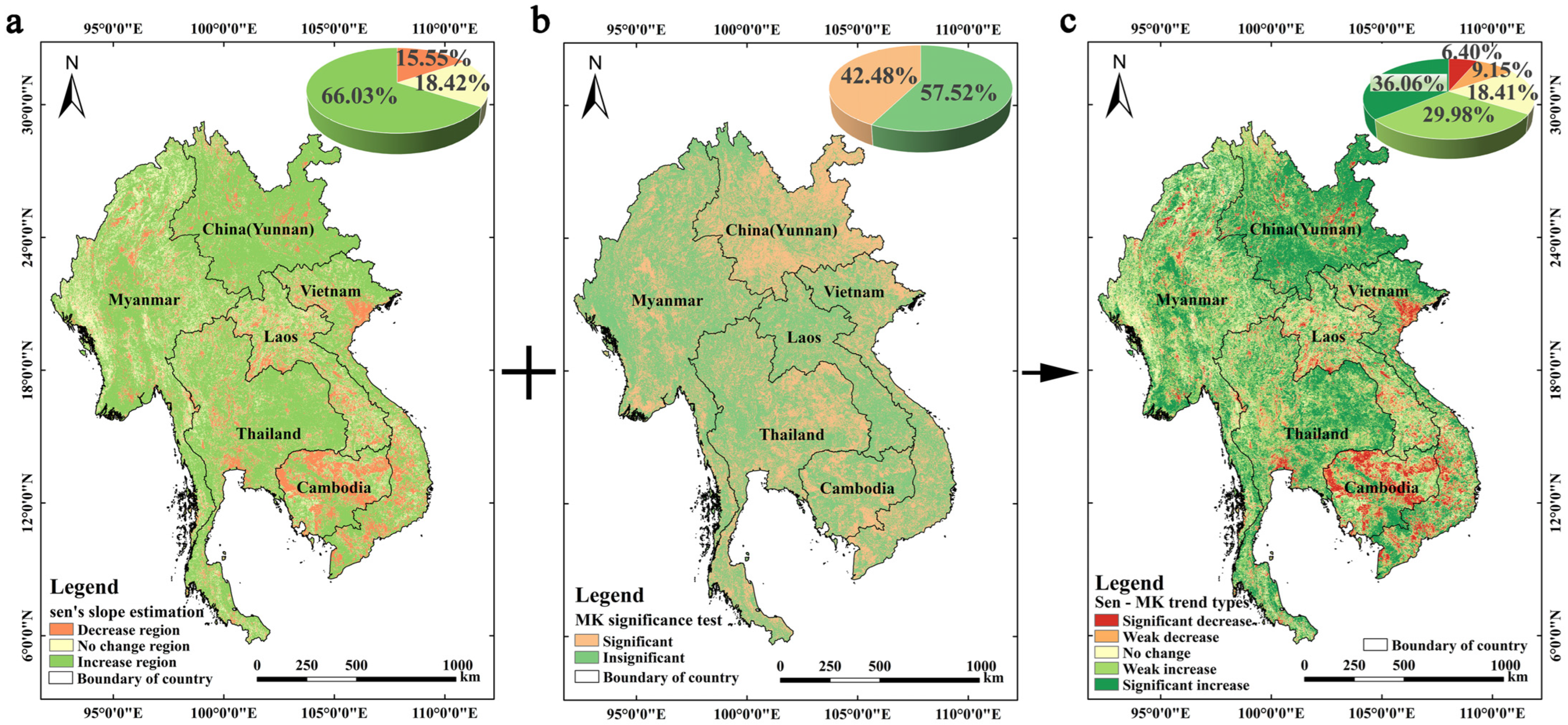
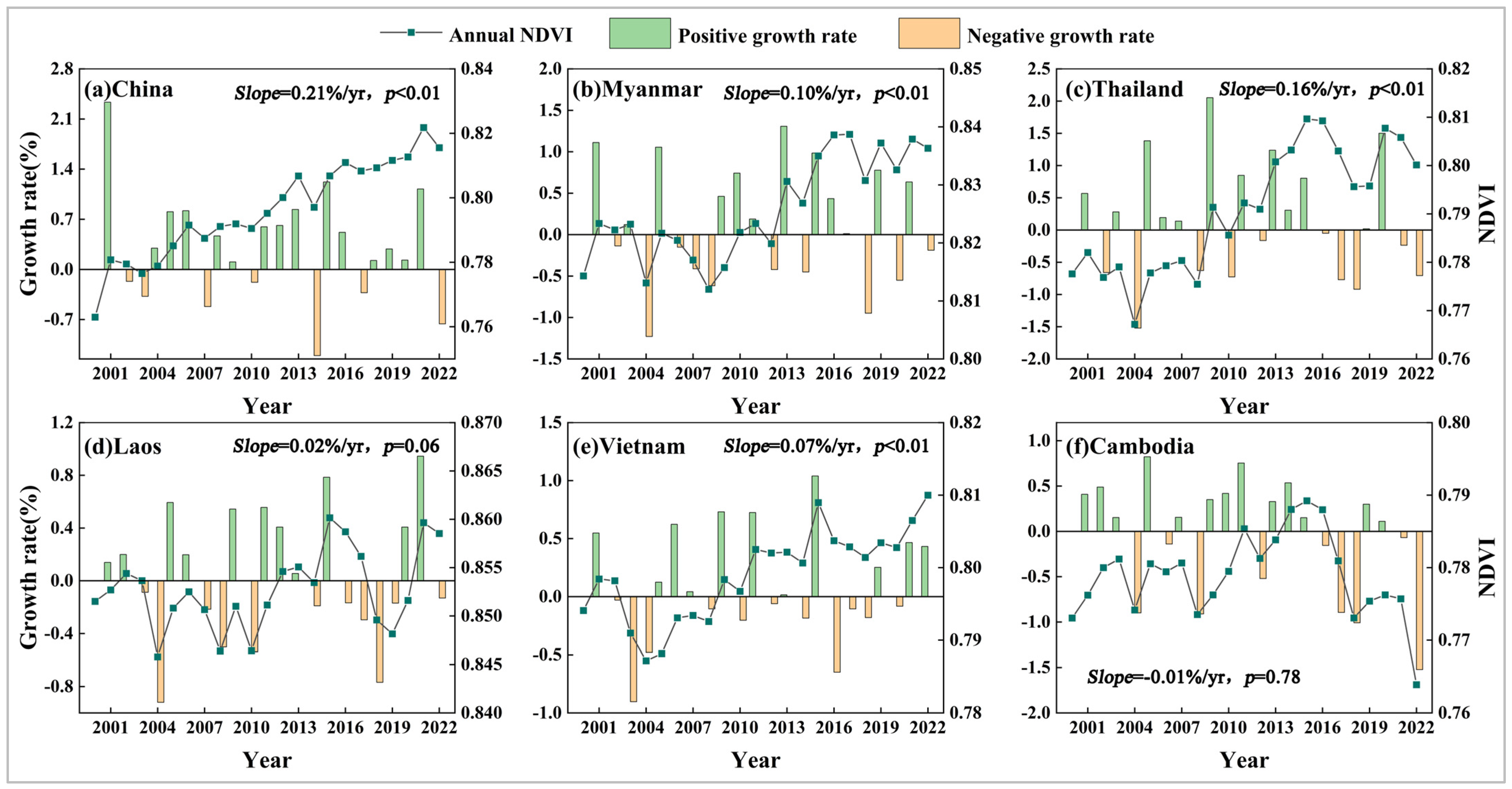
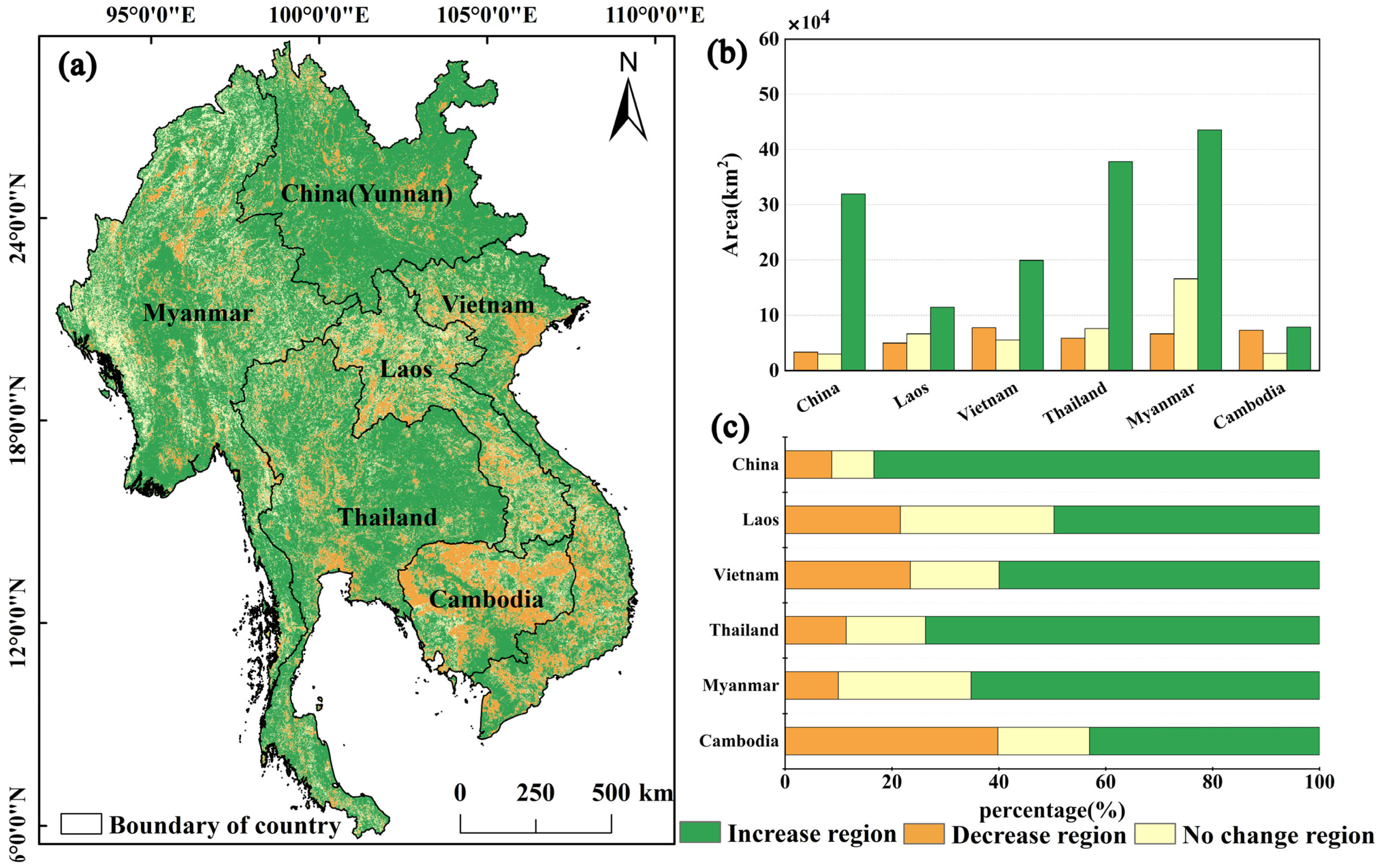
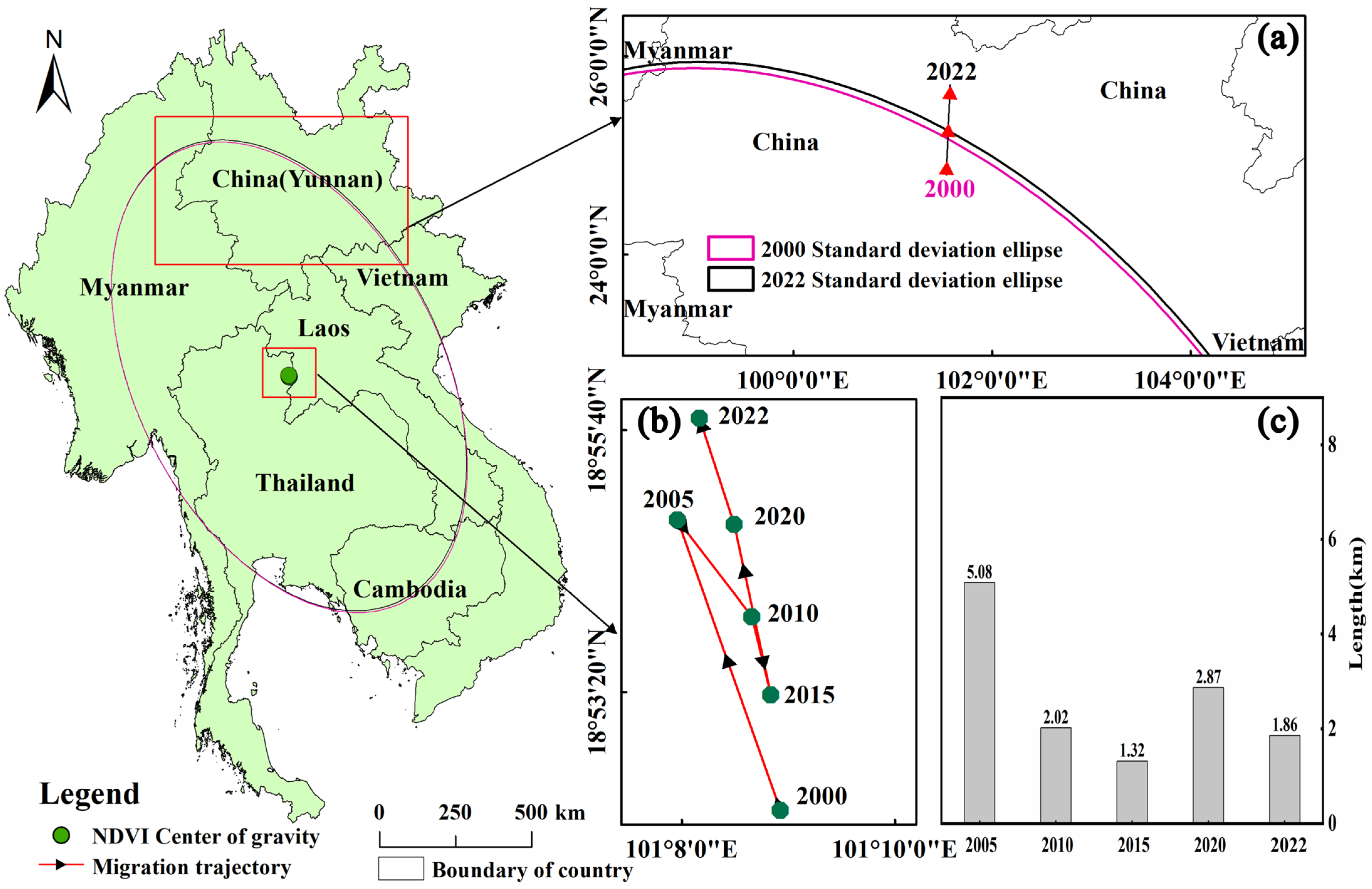
| β Value | Z Value | Sen-MK Trend Type |
|---|---|---|
| Increase β ≥ 0.0005 | Significant Z ≥ 1.96 | Significant increase |
| Increase β ≥ 0.0005 | Insignificant Z −1.96 < Z < 1.96 | Weak increase |
| No change −0.0005 < β < 0.0005 | Insignificant Z −1.96 < Z < 1.96 | No change |
| Decrease β ≤ 0.0005 | Insignificant Z −1.96 < Z < 1.96 | Weak decrease |
| Decrease β ≤ 0.0005 | Significant Z < −1.96 | Significant decrease |
Disclaimer/Publisher’s Note: The statements, opinions and data contained in all publications are solely those of the individual author(s) and contributor(s) and not of MDPI and/or the editor(s). MDPI and/or the editor(s) disclaim responsibility for any injury to people or property resulting from any ideas, methods, instructions or products referred to in the content. |
© 2024 by the authors. Licensee MDPI, Basel, Switzerland. This article is an open access article distributed under the terms and conditions of the Creative Commons Attribution (CC BY) license (https://creativecommons.org/licenses/by/4.0/).
Share and Cite
Deng, B.; Liu, C.; Zhang, E.; He, M.; Li, Y.; Duan, X. Satellite Observations Reveal Northward Vegetation Greenness Shifts in the Greater Mekong Subregion over the Past 23 Years. Remote Sens. 2024, 16, 3302. https://doi.org/10.3390/rs16173302
Deng B, Liu C, Zhang E, He M, Li Y, Duan X. Satellite Observations Reveal Northward Vegetation Greenness Shifts in the Greater Mekong Subregion over the Past 23 Years. Remote Sensing. 2024; 16(17):3302. https://doi.org/10.3390/rs16173302
Chicago/Turabian StyleDeng, Bowen, Chenli Liu, Enwei Zhang, Mengjiao He, Yawen Li, and Xingwu Duan. 2024. "Satellite Observations Reveal Northward Vegetation Greenness Shifts in the Greater Mekong Subregion over the Past 23 Years" Remote Sensing 16, no. 17: 3302. https://doi.org/10.3390/rs16173302
APA StyleDeng, B., Liu, C., Zhang, E., He, M., Li, Y., & Duan, X. (2024). Satellite Observations Reveal Northward Vegetation Greenness Shifts in the Greater Mekong Subregion over the Past 23 Years. Remote Sensing, 16(17), 3302. https://doi.org/10.3390/rs16173302







